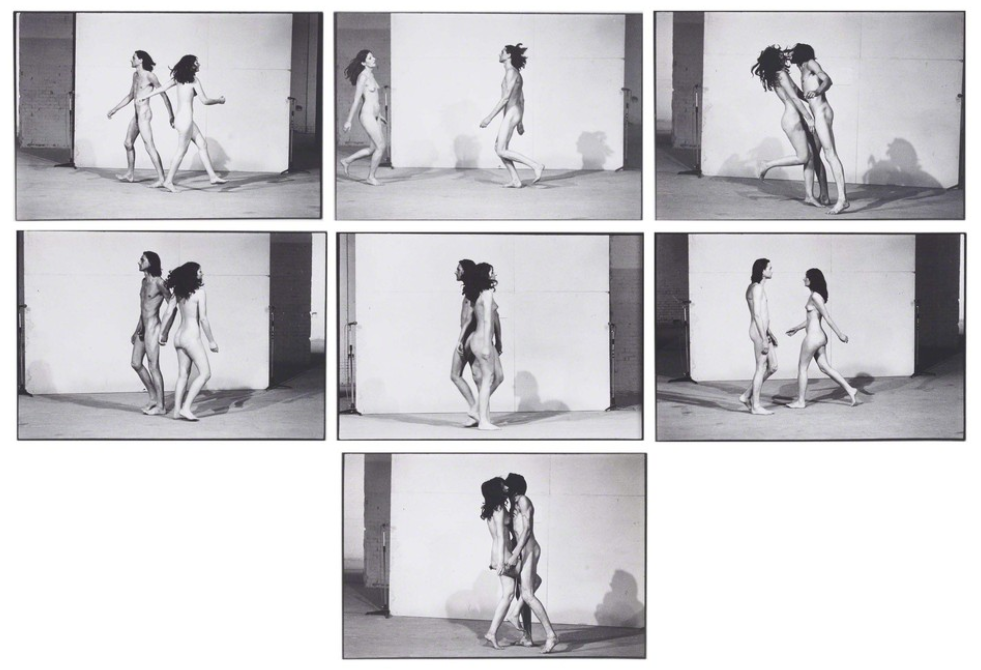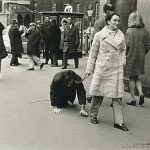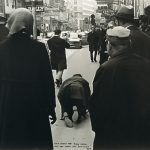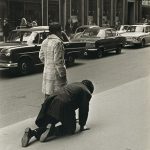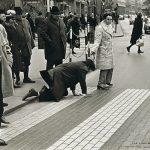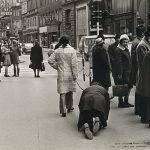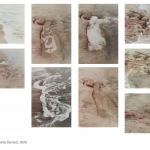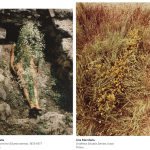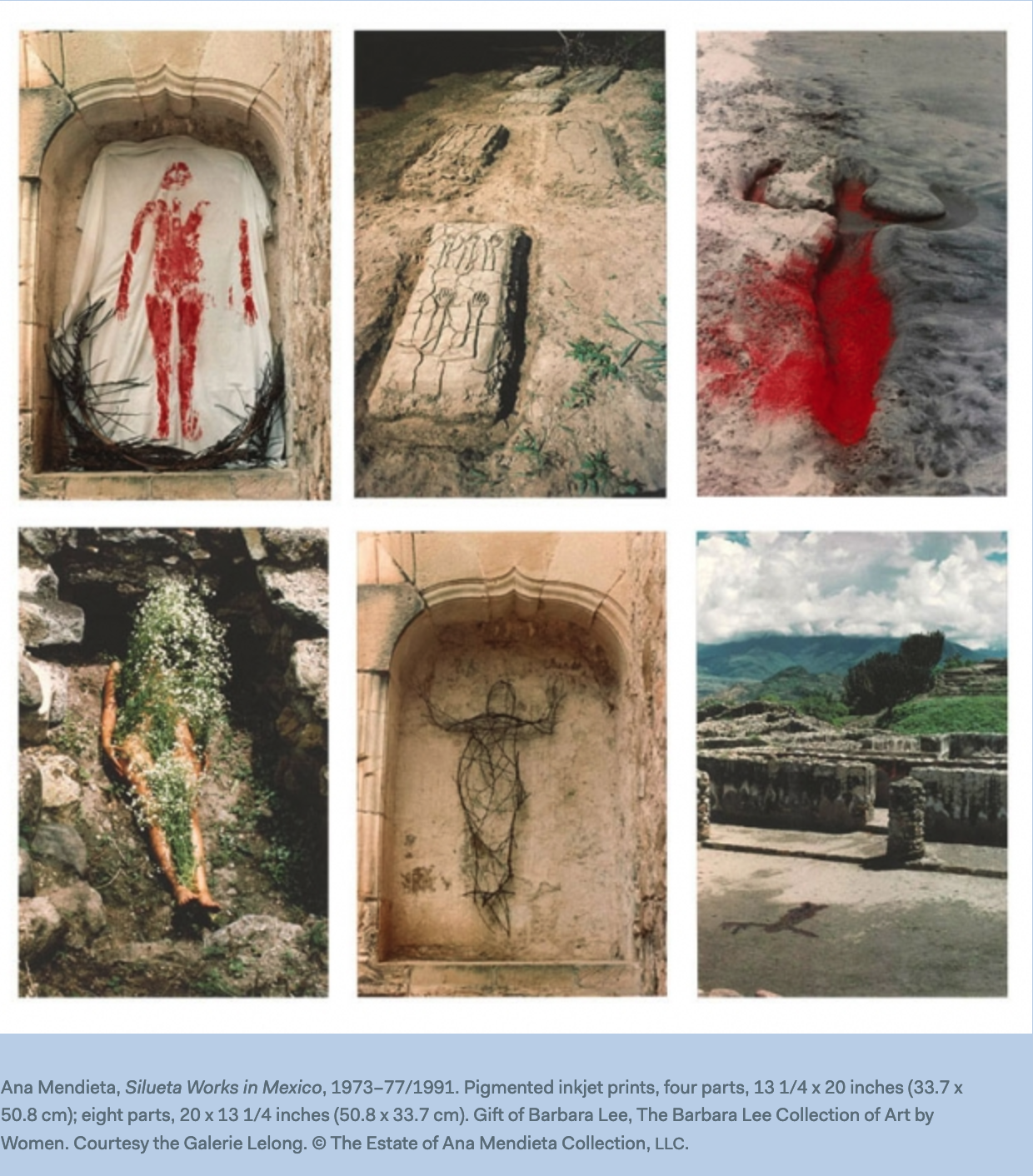“Performed on the 16th of July at the Venice Biennale in 1976 with Ulay. In Relation in Space (1976) they ran into each other repeatedly for an hour – mixing male and female energy into the third component called “that self.”” (credit)
Category Archives: Gender
VALIE EXPORT/Peter Weibel, Aus der Mappe der Hundigkeit (From the Portfolio of Doggedness) (1968)
“VALIE EXPORT/Peter Weibel, Aus der Mappe der Hundigkeit (From the Portfolio of Doggedness), (1968)
Documentation of the action 5 black-and-white photographs, vintage prints, 40.3 x 50.3 cm / 50 x 40.3 cm each, framed between 2 glass plates, flush 40.3 x 50.3 cm / 50 x 40.3 cm each, fixed with black textile adhesive tape Photographer: Josef Tandl
Five black and white photographs document the action From the Portfolio of Doggedness, which VALIE EXPORT and Peter Weibel carried out in Vienna in February 1968. EXPORT took her fellow artist for a walk—he crawled behind her on all fours on a leash—along the Kärntner Strasse in Vienna, one of the central streets and main shopping areas. This “sociological and behavioral case study” (EXPORT) belongs to the actionistic tradition. “Here the convention of humanizing animals in cartoons is turned around and transferred into reality: Man is animalized—the critique of society as a state of nature” (Weibel). Turning around a piece of normal social behavior makes transparent a particular symbolic order—that of gender specifics—and subjects it to criticism. Here, an active woman leads a passive man on a leash. Crawling, a form of animal behavior, is not, however, a reference to liberation from moral and political discipline or a “better” system. Rather, it points out the necessity of restructuring the social order that has been handed down to us. Photography has a documentary function here, it acts as an “ethno-graphical” study and shows particular communication processes in the observable reactions of the onlookers. The structures of the gazes disclose social behavior and contrast with the action. (Claudia Slanar)” (credit)
Sarah Rodigari, Strategies for Leaving and Arriving Home (2011)
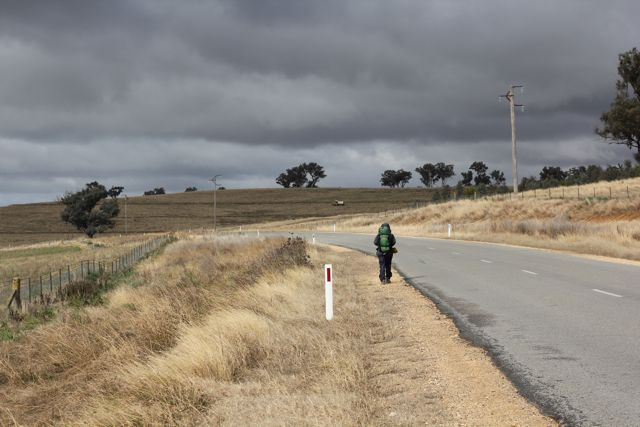
Sarah Rodigari, Strategies for Leaving and Arriving Home (2011); Photography: Adeo Esplago; Presented: Performance Space Sydney, Monash University Museum of Art, Melbourne and Artspace, Sydney as part of Art as Verb.
“Walking is a type of process-based research which informs my performance practice. I use walking alongside other social modalities such as conversation to document relational knowledge and to consider how place is historically determined, invented and retold.” (Catalog, “From Here to There: Australian Art and Walking)
—
“A six-week performative walk in which I relocated 880 kilometres from Melbourne to Sydney in the winter of 2011. I On my back I carried a tent, a sleeping bag and a four-day supply of food. As no ‘official’ walking route exists between these two cities, I mapped out my own path, choosing to follow the train line as best I could. When this was not possible, I followed the Hume Highway. I walked approximately twenty kilometres per day. I had no support vehicle; instead, I invited people to be my support by walking with me or joining me via the project blog.
In addition to documentation presented through essays, maps and the blog, I have included images of people who participated in the project by either walking, offering accommodation, food,a lift, or passing conversation and local knowledge. The inter-personal affective relations experienced in this exchange expose a vulnerability found within the embodied image of this walk: a woman walking alone along a highway. In turn, this mediation changed the process of the walk and thus shaped the nature of the project.” (credit)
Ana Mendieta, Silueta Series (1973-78)
“The “Siluetas” comprise more than 200 earth-body works that saw the artist burn, carve, and mold her silhouette into the landscapes of Iowa and Mexico. The sculptures made tangible Mendieta’s belief of the earth as goddess, rooted in Afro-Cuban Santería and the indigenous Taíno practices of her homeland. Exiled from Cuba at a young age, Mendieta said that she was “overwhelmed by the feeling of having been cast from the womb (nature).” Seeking a way to, in her words, “return to the maternal source,” she used her body to commune with sand, ice, and mud, among other natural media, as a way to “become one with the earth.”
Yet these works resist easy categorization in form or theme. The “Siluetas” are not self-portraits or performance pieces, except perhaps to the few who witnessed them. Each piece was subsumed by the earth, meaning photographs are the only remaining traces. Similarly, the thematic complexity of Mendieta’s life and these sculptures resist collapsing into neat categories of nation, diaspora, race, or gender. By using the body as both an image and medium, these aspects of identity are complicated. Mendieta’s earthworks occupy a liminal space between presence and absence, balancing the inevitable politicization of the self while searching for meaning in older, sacred traditions. …
The “Siluetas” were an ongoing, ritualistic relationship between Mendieta and the land. I read each work as a spell, a fragment of an ongoing incantation that was not “the final stage of a ritual but a way and a means of asserting my emotional ties with nature,” as Mendieta once said. She wanted to send “an image made out of smoke into the atmosphere,” so that each work was designed to disappear, to be reclaimed by the force she revered in an effort to come closer to it.” [credit]
“Spanning performance, sculpture, film, and drawing, Ana Mendieta‘s work revolves around the body, nature, and the spiritual connections between them. A Cuban exile, Mendieta came to the United States in 1961, leaving much of her family behind—a traumatic cultural separation that had a huge impact on her art. Her earliest performances, made while studying at the University of Iowa, involved manipulations to her body, often in violent contexts, such as restaged rape or murder scenes. In 1973 she began to visit pre-Columbian sites in Mexico to learn more about native Central American and Caribbean religions. During this time the natural landscape took on increasing importance in her work, invoking a spirit of renewal inspired by nature and the archetype of the feminine.1. Ana Mendieta, quoted in Petra Barreras del Rio and John Perrault, Ana Mendieta: A Retrospective, exh. cat. (New York: New Museum of Contemporary Art, 1988), p. 10.
2. Ana Mendieta, “A Selection of Statements and Notes,” Sulfur (Ypsilanti, Mich.) no. 22 (1988), p. 70.” [credit]
Anna Campbell, Saddledrag (2006-)
Specific to the 2008 iteration: “As part of her ongoing performance series Saddledrag, artist Anna Campbell dressed in self-proclaimed “cowboy drag” and pulled a cast-plaster saddle behind her. In her own words, this cowboy without a horse “hopes to critique both the construct of the American cowboys, as well as nostalgia for a romantic past that never existed.” The saddle was fully eroded by the end of the trek, leaving a two-mile double line that encircled the full parade route.”
— Credit: Uchill, Rebecca, editor. On Procession, Indianapolis Museum of Art, 2009. Page 99.
The parade, overseen by Fritz Haeg and titled East Meets West Interchange Overpass Parade, was sponsored by the Indianapolis Museum of Art and was held on April 26, 2008.
Allison Smith, The Muster (2008)
“The Muster is a one-day, open-air celebration centering on the question “What are you fighting for?” posed by artist and self-appointed Mustering Officer Allison Smith (b.1971, Manassas, VA). This public art event takes place on Governors Island, the former national military post located in New York Harbor. Once there, visitors can tour an encampment of more than 50 campsites and art installations, created by an army of “enlisted troops” selected by Smith and the Public Art Fund. The afternoon includes an array of activities—mock battles, American Folk portrait painting, magic shows, quilting bees, soapbox speeches, and more—culminating with a formal “Declaration of Causes” on a central stage.
As a military term, muster refers to a gathering of troops for the purposes of inspection, critique, exercise, and display. The Muster adopts the language and aesthetic of a Civil War reenactment. Like Civil War reenactors, participants in The Muster engage in the articulation of identities through performance and expand on the reenactor’s belief that events lost to history can gain meaning and contemporary relevance when performed live in an open, participatory manner. However, The Muster does not involve enacting a specific war from the past; instead, Smith uses the format to create an occasion and a forum for individual expression of diverse causes.
Beyond its military roots, The Muster also bears a resemblance to a country fair or an early 20th-century carnival. Blending art, craft, culture, history and social activism, the event embodies Smith’s interest in community and freedom of expression. The causes of the participants vary widely, from the political to the whimsical, addressing art history, technology, gender, democracy, and sociology.
For more information visit www.themuster.com.” [credit]
Adrian Piper, I am the Locus #2 (1975)
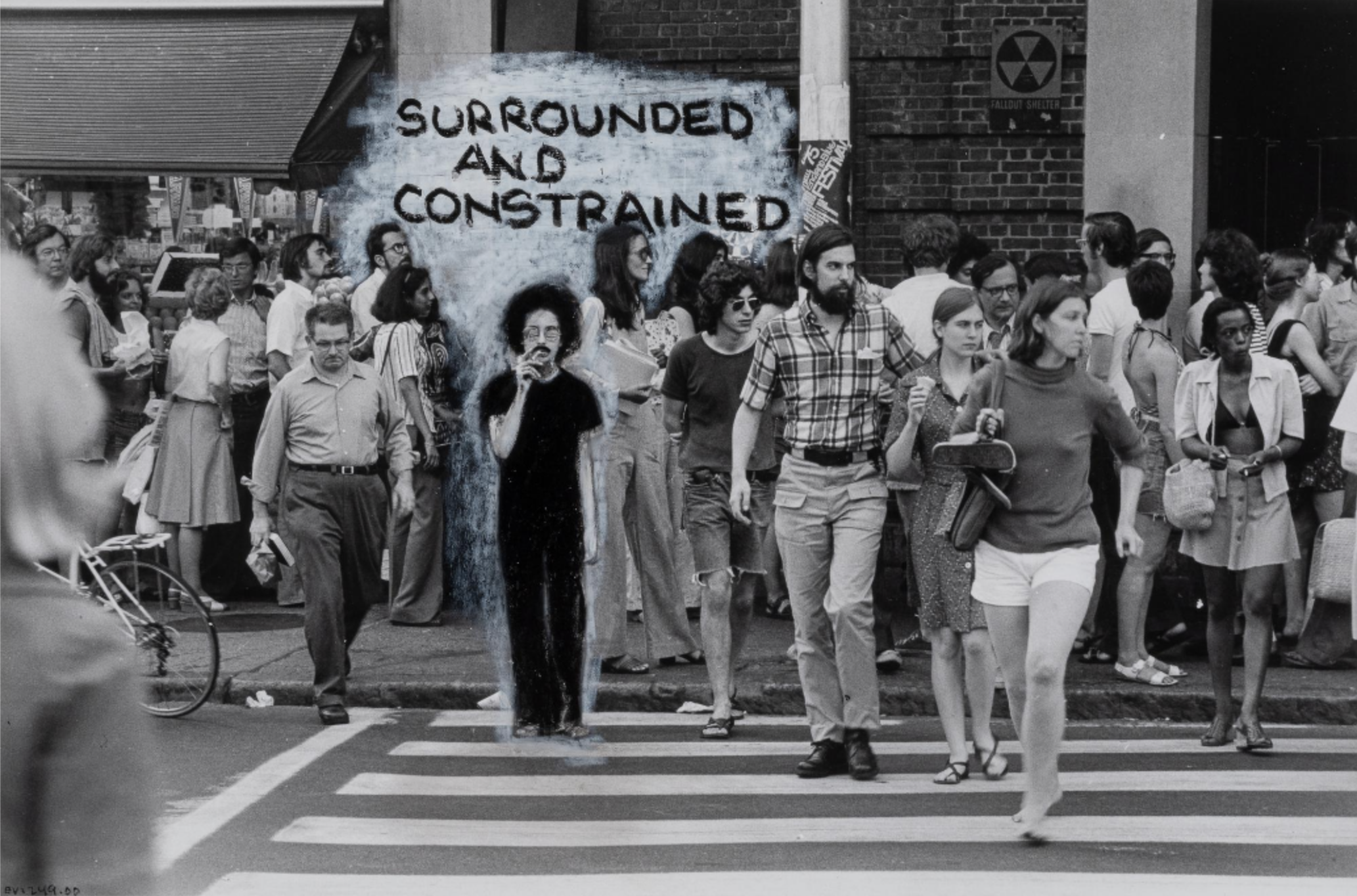
[credit]
I am the Locus (#2)
DimensionsSheet: 8 x 10 in. (20.3 x 25.4 cm)
“The series of five hand-worked photographs that comprise The Mythic Being: I am the Locus conveys Piper performing a consciousness of otherness on a walk through Harvard Square in Cambridge, Massachusetts. An American-born artist of mixed racial background, Piper has articulated questions about the politics of racial identity in many ways throughout her work as an artist and philosopher. In 1973, Piper created an alter ego, the Mythic Being, who became the basis of a pioneering series of performances and photo-based works. For this 1975 Mythic Being performance, she sported large sunglasses, an Afro wig and mustache—chosen to blend in with the mid-seventies urban environment, and dressed in men’s clothing. This simple costume enabled her to appear inconspicuously as a black man to an unknowing public. In these photographs we can perceive the indifference of the crowd in Harvard Square to Piper’s performance: people brush shoulders with her, or look in the opposite direction.
Her subsequent intervention into the photographs with oil crayon and text helps to dramatize the scenes, and to express the tension between the artist’s inner experience and the invisibility of her Mythic Being performance to its live audience. Drawing directly on the photographic prints prevents the images from being seen as straightforward documentation of a performative event. Instead, by the final sequential image, most of the other people and surroundings have been obliterated by drawing, which parallels the text’s shift from philosophical meditation (“I am the locus…”) to existential shove (“Get out of my way…”). Piper intended for these photographs to be made into posters; she did not initially intend for these preparatory images to be treated as works of art unto themselves.” [credit]
—
“In 1973 Adrian Piper pasted a mustache on her face, put on an Afro wig, and donned round, wire-rimmed shades.
Dressed and acting like a man, she went out into the streets.
Muttering passages she had memorized from her journal, the artist was startling and weird, challenging passersby to classify her through the lens of their own preconceptions about race, gender, and class.

Who was this light-skinned black man, going on and on about how his mother bought too many cookies. Was he crazy? Was he dangerous? Why was he being followed by a film crew?
These street actions formed the basis of The Mythic Being, an influential work of performance art that helped establish Piper’s reputation as provocateur and philosopher.
At a time when Conceptual and Minimal art were mostly male domains that pushed to reduce art to idea and essence, Piper pushed back with confrontational work that brought social and political issues to center stage. And at a time when most performances were barely documented, Piper announced her project in ads in the Village Voice, arranged for it to be filmed by Australian artist Peter Kennedy, and created works on paper dominated by her aggressive alter-ego.
In the catalogue for “Radical Presence: Black Performance in Contemporary Art,” currently at NYU’s Grey Art Gallery, curator Naomi Beckwith describes Mythic Being as “a seminal work of self-fashioning that both posited and critiqued models of gender and racial subjectivity.”

Footage from Mythic Being, borrowed from Kennedy, had been playing on a monitor in the Grey’s galleries until this week—when Piper requested the work be removed. The monitor was turned off and the gallery posted a note to viewers on top.

It explained that the artist had articulated her reasons in correspondence with Valerie Cassel Oliver, the show’s curator, which reads in part:
“I appreciate your intentions. Perhaps a more effective way to ‘celebrate [me], [my] work and [my] contributions to not only the art world at large, but also a generation of black artists working in performance,’ might be to curate multi-ethnic exhibitions that give American audiences the rare opportunity to measure directly the groundbreaking achievements of African American artists against those of their peers in ‘the art world at large.’”
The note responds with a statement of Cassel Oliver’s from the catalogue, arguing that the show’s mission is to resist “reductive conclusions about blackness: what it is or what it ain’t. What is clear is that it exists and has shaped and been shaped by experiences. The artists in this exhibition have defied the ‘shadow’ of marginalization and have challenged both the establishment and at times their own communities.”

In response to Piper’s request, Cassel Oliver added: “It is clear however, that some experiences are hard to transcend and that stigmas about blackness remain not only in the public’s consciousness, but also in the consciousness of artists themselves. It is my sincere hope that exhibitions such as Radical Presence can one day prove a conceptual game-changer.”
In depriving students and the larger public from seeing her work at the Grey, the artist, who currently lives in Berlin and runs a foundation dedicated to art, philosophy, and yoga, has chosen to make a larger point about marginalization and otherness, themes that have dominated her work throughout her career.
The question is whether separate exhibitions are still needed to tell the stories that were left out and continue to be absent from conventional tellings of art history, or whether creating these separate spaces amounts to a kind of ghettoization that prevents the artwork from being considered on the larger stage.

These issues are hardly confined to race, of course—curators of exhibitions on gender, nationality, and other aspects of identity routinely encounter artists who decline to participate because they don’t want to be considered in the context of “women artists,” “Jewish artists,” and so on. So, sometimes, do our contributors and photo editor when we run stories on these issues.
The organizers of “Jew York,” a show at Zach Feuer and Untitled galleries in New York last summer, were turned down by several artists who didn’t want to appear under such a rubric. Luis Camnitzer, a German-born Uruguayan artist, was so conflicted that he couldn’t decide whether to recuse himself or contribute a piece. So he sent a letter describing his conundrum, which became part of the show. It read in part: “Do I refuse the invitation on the grounds of feeling that it is an artificial and anecdotal grouping irrelevant to the work of most artists invited and therefore tinged by an aroma of weird fundamentalism? Or do I have to accept on the grounds of my need not to deny my Jewish connections bound by my ethical debt and beliefs? Maybe not totally pleasing to everybody, this letter tries to be my compromise.”

When “Radical Presence” opened at the Contemporary Arts Museum, Houston, last year, it also included five works from Piper’s 1975 series I am the Locus, collaged and painted Polaroids on which images of Piper as the Mythic Being are inserted into scenes of a crowded street. The text gets bigger as the figure approaches the viewer, culminating in the warning “Get Out of My Way, Asshole.” The works, owned by the Smart Museum at the University of Chicago, were deemed too fragile to travel to New York.
Part II of the New York version of “Radical Presence” opens at the Studio Museum in Harlem on November 14. It doesn’t include any works by Piper. The show is scheduled to travel to the Walker Art Center in Minneapolis next year.” [credit]
Lenka Clayton, The Distance I Can Be From My Son (2013)
The Distance I Can Be From My Son (Back Alley)
2013 / video series / 1:53 min
A series of videos that attempt to objectively measure the furthest distance I can be from my son in a variety of environments; a city park, a back alley and Shursave supermarket.
Made during An Artist Residency in Motherhood. [credit]
Rebecca Horn, Unicorn (1970–2) and Performances II (1973)
Unicorn appears in Horn’s 1970 film of the same name, and in her 1973 film Performances II.
“Unicorn is a white sculpture designed to be worn by a female performer. A series of vertical and horizontal white fabric straps serve as a kind of bodice that binds the performer’s naked body, with further straps connecting the neck to a tall, conical, horn-like structure that extends vertically from the top of the performer’s head. In an interview in 1993 Horn explained the development and original manifestation of this work, one of her earliest sculptures for the body:
[I had a vision] of this woman, another student. She was very tall and had a beautiful way of walking. I saw her in my mind’s eye, walking with this tall, white stick on her head which accentuated her graceful walk. I was very shy, but I started talking to her and proposed that I measure her to build this body-construction that she would have to wear naked and that would terminate in a large unicorn horn on her head. To my surprise she agreed … I invited some people and we went out to this forest at four AM. She walked all day through the fields … she was like an apparition.
(Quoted in Solomon R. Guggenheim Museum 1993, p.16.)
Developed from a 1968–9 preparatory sketch (Tate T12783), Unicorn is part of a series of body extensions – including Trunk 1967–9 (Tate T07855), Arm Extensions 1968 (Tate T07857), and Scratching Both Walls at Once 1974–5 (Tate T07846) – in which unwieldy prosthetics are used to emphasise the fragility and vulnerability of the human body. For Unicorn, however, the layers of meaning are more complex: the single woman clad in white, the original forest location and the symbolism of the unicorn reflect what curator Germano Celant has identified as Horn’s ‘intentional manifestation of white magic, in which woman tries to win out over reality and society’ (quoted in Solomon R. Guggenheim Museum 1993, p.44).
Emerging onto the art scene in the late 1960s, the German artist Rebecca Horn was part of a generation of artists whose work challenged the institutions, forces and structures that governed not only the art world but society at large. In art, this meant a renewed critical focus on the human body, contesting the commodification of art objects by foregrounding the individual. This focus on the human body took on a particular personal resonance for Horn, who was confined to hospitals and sanatoria for much of her early twenties after suffering from severe lung poisoning while working unprotected with polyester and fibreglass at Hamburg’s Academy of the Arts.
Horn has made work in a variety of media throughout her career, from drawing to installation, writing to filmmaking. Yet it is with her sculptural constructions for the body that she has undertaken the most systematic investigation of individual subjectivity. Her bodily extensions, for example, draw attention to the human need for interaction and control while also pointing to the futility of ambitions to overcome natural limitations. Similarly, her constructions, despite their medical imagery, are deliberately clumsy and functionless, while other works attest to the unacknowledged affinities between humans, animals and machines.
Further reading
Ida Gianelli (ed.), Rebecca Horn: Diving through Buster’s Bedroom, exhibition catalogue, Museum of Contemporary Art, Los Angeles 1990, pp.38–9.
Germano Celant, Nancy Spector, Giuliana Bruno and others, Rebecca Horn, exhibition catalogue, Solomon R. Guggenheim Museum, New York 1993, no.4.
Armin Zweite, Katharina Schmidt, Doris von Drathen and others, Rebecca Horn: Drawings, Sculptures, Installations, Films 1964–2006, Ostfildern 2006, pl.25.
Lucy Watling, August 2012″
[credit]
Ella Parry-Davies, Home Maker Soundwalks (2018-)
A collection of soundwalks made with Filipina domestic and care workers employed “behind closed doors” in the Lebanon and the UK. Check out the soundwalks.
